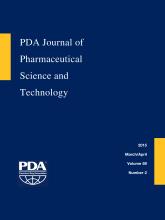Abstract
Many pharmaceutical companies are transitioning their research and development drug product pipeline from traditional small-molecule injectables to the dimension of evolving therapeutic biologics. Important concerns associated with this changeover are becoming forefront, as challenges develop of varying complexity uncommon with the synthesis and production of traditional drugs. Therefore, alternative measures must be established that aim to preserve the efficacy and functionality of a biologic that might not be implemented for small molecules. Conserving protein stability is relative to perpetuating a net equilibrium of both intrinsic and extrinsic factors. Key to sustaining this balance is the ability of container–closure systems to maintain their compatibility with the ever-changing dynamics of therapeutic biologics. Failure to recognize and adjust the material properties of packaging components to support compatibility with therapeutic biologics can compromise patient safety, drug productivity, and biological stability. This review will examine the differences between small-molecule drugs and therapeutic biologics, lay a basic foundation for understanding the stability of therapeutic biologics, and demonstrate potential sources of container–closure systems' incompatibilities with therapeutic biologics at a mechanistic level.
LAY ABSTRACT: Many pharmaceutical companies are transitioning their research and development drug product pipeline from traditional small-molecule injectables to recombinantly derived therapeutic biologics. Concerns associated with this transformation are becoming prominent, as therapeutic biologics are uncharacteristic to small-molecule drugs.
Maintaining the stability of a therapeutic biologic is a combination of balancing intrinsic factors and external elements within the biologic's microenvironment. An important aspect of this balance is relegated to the overall compatibility of primary, parenteral container–closure systems with therapeutic biologics. A packaging component within a container–closure system that is incompatible with the therapeutic biologic can potentially compromise patient safety, drug productivity, and product quality. Thus, each primary, parenteral packaging component within a container–closure system should be optimized to preserve the efficacy and therapeutic activity of a biologic. This review will examine the differences between small-molecule drugs and therapeutic biologics, lay a basic foundation for understanding the stability of therapeutic biologics, and demonstrate potential sources of container–closure system incompatibilities with therapeutic biologics at a mechanistic level.
- © PDA, Inc. 2015
PDA members receive access to all articles published in the current year and previous volume year. Institutional subscribers received access to all content. Log in below to receive access to this article if you are either of these.
If you are neither or you are a PDA member trying to access an article outside of your membership license, then you must purchase access to this article (below). If you do not have a username or password for JPST, you will be required to create an account prior to purchasing.
Full issue PDFs are for PDA members only.
Note to pda.org users
The PDA and PDA bookstore websites (www.pda.org and www.pda.org/bookstore) are separate websites from the PDA JPST website. When you first join PDA, your initial UserID and Password are sent to HighWirePress to create your PDA JPST account. Subsequent UserrID and Password changes required at the PDA websites will not pass on to PDA JPST and vice versa. If you forget your PDA JPST UserID and/or Password, you can request help to retrieve UserID and reset Password below.






